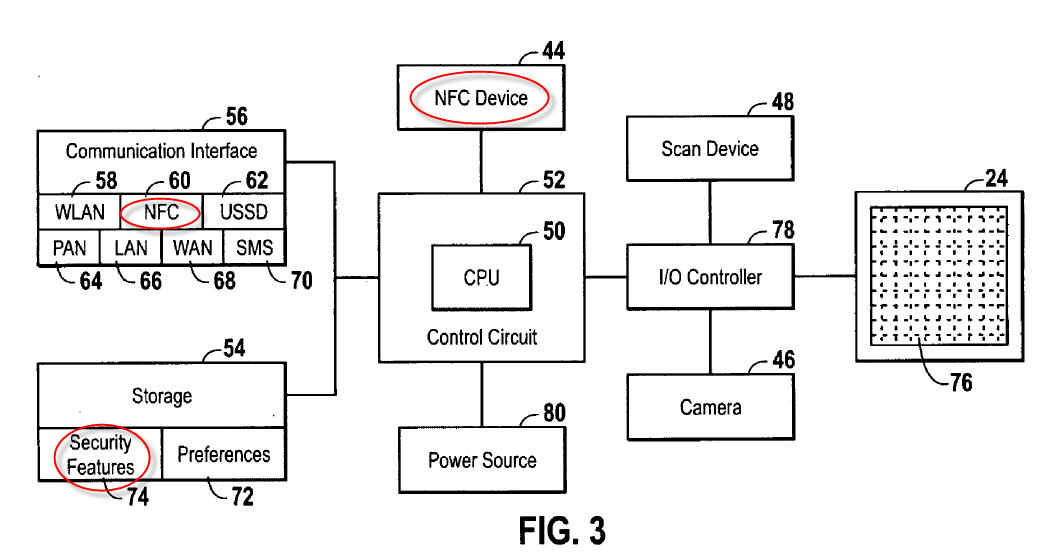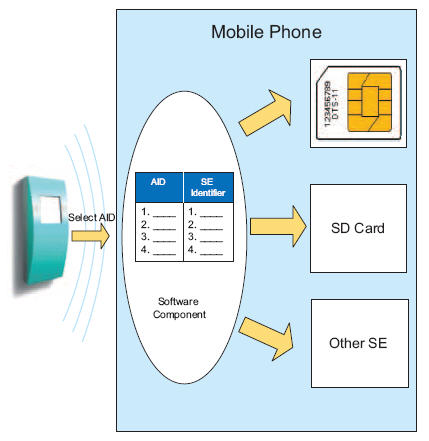Update Mar 14
No NFC for iPhone 5. Too many architecture considerations.. (below). So while their patents clearly indicate it is in their plans.. they have not been able to coordinate all of the design into their iPhone 5 program (from hardware through software and apps).
See article from UK’s Independent
Update Mar 3
Multiple SEs are too complicated for Apple. Think they actually want to control everything and have one wallet with multiple cards. So much for ISIS having a TSM. Verizon/AT&T must be pushing back.. why subsidize the iPhone and let Apple control it? My guess is that JPM and Visa are also Apple launch partners (which further diminishes ISIS value prop). The downside of controlling everything.. is that YOUR TEAM becomes a throttle to success.
Feb 21 2011 (Updated)
Apple is a tremendous company, beyond its design and technical prowess the factor that most impresses me is its unique ability to maintain confidential information. How can such amazing innovation come out of a company that seems to operate as a mix between the CIA and the Hotel California (checkout any time you like… but you can never leave…)?
Last week Brian White of Ticonderoga Securities spoke of Apple’s plans for NFC with a unique twist. So what is the “twist? My guess is that the TWIST relates to Apple’s plan to support multiple Secure Elements (ie, one embedded, another in UICC). This would allow Apple to “support” MNOs driven initiatives and also create a closed system (described in many patents below).
For background on multi SEs see GSMA whitepaper
The GSMA NFC project recommends the UICC as the most appropriate secure element (SE) in mobile phones. It is foreseen that other secure elements (removable and non removable) may be implemented in mobile phones. As a consequence, applications may be hosted in secure elements other than the UICC. The selection of the secure element hosting the targeted application shall be solved. This case only applies in card emulation mode.
Most NFC pilots have launched with a single application in a simplified environment. The long term future of what NFC really looks like is very, very hazy. Many potential complexities arise, as best described in the Stolpan whitepaper (a EU consortium now largely defunct, an irony in its own right). Apple (or ANY MNO) certainly can’t build a business on this complexity. A multi SE architecture could also provide Apple with a mechanism to address anti-trust challenges on platform fees and openness/control (Washington Post – Apple’s Subscription Model Sparks Antitrust Concerns). Apple would compete on quality of service and integration, but allow other applications to also “exist” in a separate environment with a different “trust”.
The champion of Multi SE architecture is Inside Contactless (OpenNFC).. a very very smart “Judo” move that leverages NXP’s substantial momentum (in integrated NFC/controller/radio) against itself. Inside’s perspective is that there is no reason for the ISO 14443 radio to ONLY be controlled via NFC (treat it like a camera). Inside’s OpenNFC provides for “easily adaptable hardware abstraction software layer, which accounts for a very small percentage of the total stack code, meaning that the Open NFC software stack can be easily leveraged for different NFC chip hardwalet multiple applications and services access it”. Handset manufactures love this model.. MNOs hate it. As I stated previously, closed systems must develop prior to open systems as investment can only be made where margins and services can be controlled. OpenNFC changes the investment dynamics for MNOs, and provides new incentives for Google/Apple/Microsoft, … to transition their closed systems into NFC platforms.
Along these lines (Apple AppStore into NFC Platform), I need to correct the assertion I made in my previous blog Apple and NFC. In it I stated that NFC “control” for Apple was about advertising control (not payment revenue). What if Apple evolves all of its current applications into a “trusted” (in NFC context) environment, with secure storage and access restrictions (GPS, Alerts, phone, camera, NFC element, payment, advertising, enforced customer anonymity, …)? Apple could also enable this new architecture to support new secure areas for the Mobile operator (or other TSM) to provision secure services, or even an “open area” where the customer can run anything they want. In this multiple secure element example, Apple would seek to control (and monetize) access to device services and seek to INCENT all providers to run within the APPLE SECURE ENVIRONMENT.. but would provide an alternative (that it does not manage, support or control).
If this is indeed Apple’s plan I will have to update my prognostication on the death of mobile apps (in favor of HTML 5). Particularly for Apps that leverage any of the Apple services I list above. This scenario is consistent with Apple’s Patent US10200082444 PORTABLE POINT OF PURCHASE USER INTERFACES
[0088] Close range communication may occur through the NFC interface 60. The near field communication (NFC) interface 60 may operate in conjunction with the NFC device 44 to allow for close range communication. The NFC interface 60 may exist as a separate component, may be integrated into another chipset, or may be integrated with the NFC device 44, for example, as part of a system on a chip (SoC). The NFC interface 60 may include one or more protocols, such as the Near Field Communication Interface and Protocols (NFCIP- 1) for communicating with another NFC enabled device. The protocols may be used to adapt the communication speed and to designate one of the connected devices as the initiator device that controls the near field communication. In certain embodiments, the NFC interface 60 may be used to receive information, such as the service set identifier (SSID), channel, and encryption key, used to connect through another communication interface 58, 64, 66, or 68.
[092] … The security features 74 may be particularly useful when transmitting payment information, such as credit card information or bank account information. The security features 74 also may include a secure storage area that may have restricted access. For example, a pin or other verification may need to be provided to access the secure storage area. In certain embodiments, some or all of the preferences 72 may be stored within the secure storage area. Further, security information, such as an authentication key, for communicating with a retail server may be stored within the secure storage area. In certain embodiments, the secure storage area may include a microcontroller embedded within the electronic device 10.
There are 4 market forces at work which may drive a multi-SE approach
Your feedback is welcome
– Tom
Other Information


Pingback: OpenNFC – Game Changer « FinVentures
Pingback: Google wins in NFC! No NFC for Apple’s iPhone 5 « FinVentures
Pingback: Nexus S – Verizon’s Plan B « FinVentures